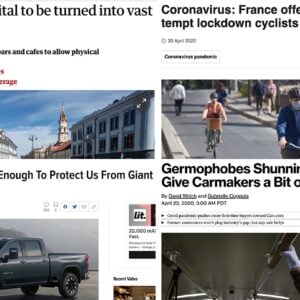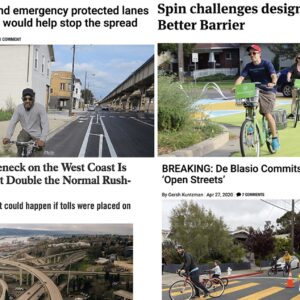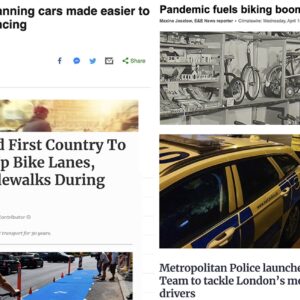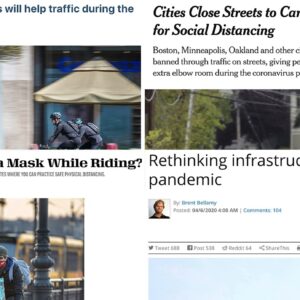Welcome to the week. Here are the most noteworthy items the BikePortland community came across in the past seven days…
Biking boost: As part of a multi-billion dollar coronavirus stimulus plan, the U.K. government will set-aside $300 million specifically to “Immediately fast-track statutory guidance to cater for significantly increased cycling and walking.”
Bike share future: PBOT’s contract talks for Biketown 2.0 just got more fraught as Uber has sold off its micromobility business (which included Jump bike share) to Lime. The move has left Seattle without any bike share at all.
The scourge of big trucks and SUVs: Happy to see Outside devote so much space to, “The Inconvenient Truth About Your Adventuremobile” and what we need to do about scary, super-sized vehicles.
More space, more speed: A dramatic drop in drivers has led to a commensurate rise in deaths according to data from Massachusetts.
Advertisement
Race and open streets in Chicago: A good summary of the open streets debate in Chicago, where advocates have clashed over how racial and economic disparities should influence any proposed changes.
Change in tone: Chicago’s main bike/walk advocacy group initially opposed Covid-19 related street changes due to equity concerns; but now they feel the time is right to move forward.
Rail > air: The French government says if Air France wants big virus bailout, they can’t fly on routes covered by existing rail network.
Eating disorders in the peloton: A former professional cyclist says the dysfunctional environment around some cycling teams — especially among women athletes — and a host of other influences led her down the road to bulimia and serious body image issues.
Re-wilding the Strip: Even the famous Las Vegas Strip has become an organic ciclovia due to casino/hotel closures and Americans’ love of riding bikes.
Advertisement
Covid mobility choices: Portland-based researchers are part of a national effort to analyze and understand how urbanites’ micromobility and transit use has changed due to the pandemic.
Transit exodus: Japanese commuters are opting for bikes instead of crowded trains — another sign that Portland better prepare for a big move away from transit in the weeks and months to come.
Streets are for eating: When the Mayor of Kansas City is talking about using main streets for restaurant customers and creating “pedestrian plazas,” you know we’re having a moment. (Note: Commissioner Chloe Eudaly says she’s considering this idea as well).
Quarantine fatigue: The Great Re-opening is upon us. This piece in The Atlantic from an epidemiologist offers good perspective and insights about how to move forward without shaming others.
— Jonathan Maus: (503) 706-8804, @jonathan_maus on Twitter and jonathan@bikeportland.org
— Get our headlines delivered to your inbox.
— Support this independent community media outlet with a one-time contribution or monthly subscription.







Thanks for reading.
BikePortland has served this community with independent community journalism since 2005. We rely on subscriptions from readers like you to survive. Your financial support is vital in keeping this valuable resource alive and well.
Please subscribe today to strengthen and expand our work.
Adventuremobile article: “Americans love light trucks because they want the most vehicle for the dollar”
That is pretty funny, given that those vehicles offer the highest profit margins for the companies that produce and sell them.
What exactly is a “light truck” nowadays? Even what passes for a small truck seems like a massive beast to me.
For purposes of CAFE almost everything…;-).
For CAFE and other government purposes, “light trucks” mostly includes SUVs and so-called light-duty pickups: F-150s and the “1500” series of non-Ford pickups, generally with a GVWR under 8500 lb. “Heavy duty” and “super duty” pickups from the F-250/2500 series on up are exempt, as are/were a small handful of SUVs (Hummer H2 and Ford Excursion come to mind).
It’s insane. When you look at the total cost of ownership over the life of the vehicle, it’s tens of thousands more. That occasional trip to the dump or hauling a load of gravel is costing these people thousands every year. Unless you are using once every few weeks as a truck, it’s cheaper to rent.
You should have seen the hopped up pavement princess I saw yesterday at a Plaid Pantry while I was on my ride yesterday west of town. It looked like a Tonka truck…and was way too clean and shiny to be a work vehicle. I was joking with my friend that the bed would be spotless, but it was nearly too high to even see into.
Speaking of too high, Parks’ parking patrol at Willamette Park uses a standard car to patrol the lot to make sure people are paying, and you can’t see the payment stubs on the dashboards of the many huge trucks there from car driver eye level. But the patroller doesn’t get out of his car to check on ones he can’t see. So I’d guess your chances of getting a ticket are much greater if you drive a car than a large truck. I guess that makes sense since Parks also charges more (double for all day) for parking a car in a single space there than a truck with trailer in a double space.
I have rented trucks from U-haul and Zipcar for this very purpose many, many times.
Actually, lately I’ve been going to a load-it-yourself landscaping place nearby, and just filling up a whole bunch of buckets and containers and hauling them in my moderately sized car. I can carry close to 1/3 of a cubic yard (probably a couple hundred pounds over the GVWR, but I’m going less than a mile with it), so I don’t even bother renting anymore. And if you need more than a yard or two of dirt, you’re better off having it delivered anyway.
It would be fun to try it with our Madsen cargo bike, but even with its 600lb limit it would take a lot more trips.
I’ve been taking a look at all the buses that I pass or pass me when I ride these days. They have had very few riders. I don’t think I’ve seen more than 3 riders on a bus and 1 the norm but I ride around mostly the west hills which are not super busy in any environment. I think mass transit is going to take a decade to recover from this mess. On many of the routes I think you could run a minivan instead of a giant diesel exhaust spewing bus.
A minivan? Sounds a lot more crowded than a mostly empty Trimet bus to me. I think you are missing the social distance part.
Three bikes would solve the dilemma of needless fuel consumption much more effectively than one minivan.
Sure, but how long would it take to pull someone on a bicycle from the West side to a job downtown?
How would strangers socially distance in a minivan?
That was my point. Let’s see how many downvotes you get 😉
I always downvote myself.
Well, of course TriMet buses are mostly empty, since riders are requested to use transit for essential trips only. Here in MN we have the same rule, but I still see plenty of people waiting at bus stops in poorer parts of town. Buses may be running at reduced capacity, but they are still being used.
I agree mass transit is going to take a long time to recover, and in some ways it may not recover. I suspect it’s going to collapse in many smaller cities where it’s not well established.
But I fear even in other areas large cutbacks may have to be made to balance the books, which impairs the functioning of the entire system: even the popular, high-frequency core routes are heavily dependent on connections with lower-demand routes, so people can make complete trips. Reducing on more marginal routes to save money will still impact demand for the main services.
One thing that bodes well for TriMet: although its startup costs are vastly higher, light rail is cheaper per passenger to operate than buses. It’s very unlikely you’ll see light rail lines get shut down, and hopefully the busiest bus lines will keep going too. But I’m guessing that federal funding for future big-buck rail projects is going to be in serious jeopardy soon.
Here in the MN we’re putting more of our eggs in the arterial-BRT basket, like what’s envisioned for Powell. We have two of these lines in operation currently, with another new aBRT line planned to come online pretty much every year for the next decade. Those will probably keep running, as will our light rail lines (2 running, a third with construction well underway, a fourth coming soon).
What I’ll be interested to see is whether our express commuter-bus service (something only found in Portland with the 92X line and maybe a couple of C-Tran lines), comprising infrequent but very fast service from distant suburban areas into downtown (buses get to travel on freeway shoulders) will recover well from this pandemic. Will suburban-living office workers keep taking these buses downtown, or will they be too scared to ride the bus now? Will they then continue working from home at higher rates than others due to the high cost of parking downtown?
The same kind of thinking ( me, me ,me) that makes people think it is alright to drive big dangerous SUV’s and pickups will probably doom us to being the worst in the world in taming the corona virus. Many people in the U.S. have no sense of communal responsibility both when it comes to their dangerous driving choices and how they behave with regards to spreading an infectious disease. A certain kind of individualistic frontier thinking has always been used to justify this when it comes to what we drive, but now that we face a much more serious predicament it may doom us to wave after wave of infections while more community minded places will be able to return to something like normal.
If we use the phrase “women athletes,” then would we say “men athletes” or “men and women athletes?” If the author wouldn’t say something like that, then shouldn’t it be “female athletes?” Female athletes definitely sounds much better.
Look Better also!
The heading: “Transit exodus: Japanese commuters are opting for bikes instead of crowded trains — another sign that Portland better prepare for a big move away from transit in the weeks and months to come.” is rather misleading. Your PUBLIC transit, like the roads you use, are a commodity you pay for whether you use them or not. Bus fares nor road tolling hardly pay for the cost of each trip; the cost difference is made up for through taxes of various sorts, federal, state, and local. But there’s also PRIVATE transit, such as taxis, car share, scooters, bicycling, walking, SOV driving, etc. which will continue to be used to varying degrees which you also subsidize heavily if indirectly.
Just so I understand your comment correctly, are you saying that bicycling (to pick the most relevant item from your list) is subsidized through federal, state, and local taxes? Presumably you are referring to the gas tax and other fees assessed on motor vehicles that pay for maintenance and upkeep of our public streets that do not accrue to people enjoying those streets for bicycling?
The streets you ride on you paid for with your various motor vehicle taxes, as well as a portion of the shipping fees you paid with FedEx, Ups, etc. The frame was most likely made in China as were your parts, shipped to the USA by sea or air, processed in US ports you helped subsidize, inspected by custom officials you paid for, tariffs collected, items sent to the distributor then the bike shop (or online retailer). At several points, your taxes (and mine) subsidized your bike use and purchase. People who walk also use the street (in SW and East Portland) or the sidewalk, some of which was paid for by the city.
My point is twofold:
First, if the old traffic patterns are re-established, then Portland’s already congested pre-covid traffic will get dramatically worse by the huge drop in bus and light rail ridership, even if many people opt for riding their bikes instead of driving their cars using obscenely cheap gasoline (very unlikely). Unlike Japan, Portland has merely OK transit but excellent roadways for car driving and lots of cheap car parking.
And property taxes.
But secondly, if our old traffic patterns are permanently disrupted and more people are working from home or totally unemployed, then there’s no reason for anyone to go downtown, as PSU is already online, stores are closed and businesses bankrupt, and even government will have to lay off personnel. Effectively downtown Portland becomes just another boarded-up suburb, with empty light rail trains. But TriMet can redirect the buses to where people want to go.
Two or three bankrupt hotels could soak up a lot of the people camping on the sidewalks. Of course some of the excess capacity may not even be finished, so the SW 10th / Alder food cart location, formerly a vibrant people magnet, might remain a big deep hole.
So we are caught in a social bind. Either we go back to being socially active to resuscitate that certain Portland vibe (and SF, Seattle, NYC, etc) and accept that people will get sick and more likely die as we hang around each other and use public transit. Or we continue to social distance and encourage sprawl and low density suburban development, which will accelerate climate change and the loss of useful land for farming and recreation. Why live in Portland if it looks and feels just like Peoria, Macon or Omaha, but at 4 times the rent?
Except if what you saying is true and the new normal is to live somewhere less crowded, and far from virus spreading venues then Portland will not be 4 times the rent. In fact it may be trendier and more expensive to live in the suburbs of Omaha than Portland. In the late 1950’s Detroit was the richest per capita city in the U.S. and 20 years later it had more or less economically collapsed. So maybe old Portland will come back in a few years.
Come back in a decade or two and ask us!
Seems like a little population control might help out with the Climate Change worries.
Yeah, but this the wrong disease – it seems to be killing the over-65s in retirement homes and out-of-season world travelers rather than the drivers of huge SUVs. But grounding all the airliners is a step in the right direction.
Maybe China can engineer a better virus. j/k.
I am hearing a lot of discussion about people moving to smaller cities in the wake of this. Partly because of the false meme that density is what’s killing all those folks in New York and Milan (spoiler alert: it’s actually mostly because the virus hit those places first, and the virus made too much headway before social distancing began).
But also because a lot of employers are seeing that remote work hasn’t been an unmitigated disaster. Yes there are problems (many of which haven’t really been addressed, just 2 months in). Having now done it for 5 years myself I know it is not a panacea, but the problems can be managed. A lot of people are going to start asking why they live in an expensive, congested metropolis like LA, Seattle or Boston if they can now do the same work in a lower-cost, equally if not more livable city like Boise, Albuquerque or Des Moines? Or maybe even something smaller like Prineville, Bisbee or Sioux City? Taking it even further (smaller) you might also see a big increase in demand for small-town and rural residential properties (ones with solid broadband service, that is) from all these new remote workers. That might cause big changes to rural economies, both good (economic stimulation) and bad (housing costs for low-paid rural workers).
That doesn’t mean Portland will see much of an easing, since people are moving there more for the lifestyle than for jobs. If anything, you might see an increased influx of high-salaried people freed from having to commute to offices in New York and the Bay Area.
That density facilitates the spread of disease is not a “false meme”; it is a generally accepted epidemiological fact. Transimission of viral diseases depends on contact between people. It is hard to dispute that on an average day, a typical New Yorker comes into contact with many more people than someone in, say, Atlanta.
Density is a factor, but so are local travel habits, the institutional response/capacity, as well as GlowBoy’s all-important point about the timing* of social distance measures.
* see https://trumpdeathclock.com/
It is a false meme in how it’s being applied, constantly being used to argue against the kind of density we’re trying to create in places like Portland and Minneapolis, which is far less than you have in Manhattan or San Francisco.
A typical New Yorker might come into close contact with more people than someone in Atlanta. But a person in a relatively “dense” neighborhood of Atlanta, or Minneapolis, or Portland, doesn’t really come into any more people over the course of a typical day than a person in Buckhead, or Bloomington, or Beaverton. In both the cities and suburbs of these non-NY metro areas, people gather in bars, restaurants, clubs, arenas, theaters, schools and offices at pretty much the same rates. Transit is the only real difference between the urban and suburban groups, but is probably not as big a factor in transmission as those other venues.
And by the way, notice how San Francisco doesn’t have anywhere near the death rate as New York, even though it is easily #2 in density, not that far behind? Again, it’s a function of when on the curve restrictions took effect. We were all stunned when the Bay Area imposed their lockdown … and then, within a week, we were all under the same rules. It worked. It took effect too late in NYC to prevent disaster.
The “Inconvenient Truth” article is well-reasoned and important, but I do want to call out one phrase that I find disagreeable: “Modern truck and full-size SUVs favor blocky, muscular styling at the front end…”
The word “muscular” is wrongly complimentary. With no body-shaming intended, isn’t an oversized front midsection more akin to obesity than to muscularity?
Morbidly circumferentially-challenged is I think the PC phrase you are looking for…
And I do know many women who in fact prefer to own such vehicles because they feel safer in them, even as statistics say otherwise about their actual safety records.
I think modern trucks look more and more like Transformers.
“Muscular” in the design world is often shorthand for sharp edges, often combined with bold shapes.
Since you don’t like truck bodies being described as “muscular”, what are your thoughts on brakes being described as “ABS”?
Well, you and I might think of it in obesity terms, but these vehicles are specifically styled and designed to imply muscularity and machismo.
THPRD is starting to study a bike/ped bridge over HWY 26 near Cedar Mill.
This would be a fantastic link over the highway that’s sorely lacking safe crossings.
http://www.thprd.org/connect/news/thprd-exploring-options-to-connect-the-westside-trail-over-highway-26-
Where in Cedar Mill would this go? Existing nearby crossings are Murray (not horrible, not great), Cedar Hills Blvd (kinda terrible with the freeway traffic flows there, but at least it’s a crossing) and the Sunset transit station (low-stress unless you have a cargo bike and the elevator is out).
Seems like the 118th-Saltzman area (near Market of Choice), or just east of there at one of the creeks, would be a good place to put it, and would avoid some nasty hill climbing for a lot of people.
Oops, didn’t see the THPRD link in your post at first. I think a Sunset High – Greenbrier doesn’t split as large or critical a gap in freeway crossing options as what I suggested above, but would still have a lot of value – especially if it helps complete the Westside Trail, which I’ve been wondering about for a while.
Off topic, but to the north of 26 is it safe to assume the route would follow the Oak Hills trail system? Might be some interesting property-ownership issues to resolve there, since those trails are currently posted as for local residents only. Not that I haven’t ridden those trails within the last few months (for the record, not that I have either), but hey those signs so small you can’t read them when you’re on a bike.
I think that it’s a logical location, especially for a low stress crossing. The problem with Cedar Hills, Murray, and Cornell/Bethany crossings is that they are all interacting with fast moving traffic coming on and off the highway. This one can tie into employment areas, retail areas and residential areas.
On the topic of Oak Hills, the section of land where the eventual Westside Trail will go (under the power lines) is actually owned by the Bonneiville Power Administration not by the Oak Hills HOA. Oak Hills has just claimed it as their own. I’m sure that they’ll throw a huge tantrum when that portion of trail planning gets underway. This is just speculation in my part, but I would imagine that is the reason why THPRD hasn’t already built out the section of trail between Cornell and Kaiser Rd. That section is much less technically challenging than other segments on the Westside/Waterhouse trail as there’s not as much elevation or wetlands to deal with. It’s the political/legal fight that THPRD doesn’t want to deal with.
Oh, that’s interesting, and I should have realized that was BPA land. I won’t worry about the signs next time I ride there (whenever that is!), since the HOA’s claim on those trails is probably unenforceable, at least under the power lines.
Was that an editorial decision, highlighting the word ‘says’ on the Chloe Eudaly bit? Seems like you could have picked some other word(s) that did not skew that way.
How exactly does it “skew” to you? (Also… FWIW I’m not sure why but seems like an awful lot of readers lately are speculating about my motives and reading things into my work that I never intended.). It’s just a link. That’s the word I chose to put the link in. That’s it.
The word ‘says’ is highlighted. Graphically it’s a strong emphasis, like a bold face on steroids. Imagine a third person reading it aloud. Perhaps that wasn’t your intent but it doesn’t seem like a reach for a person who doesn’t know your mind to conclude it was meant.